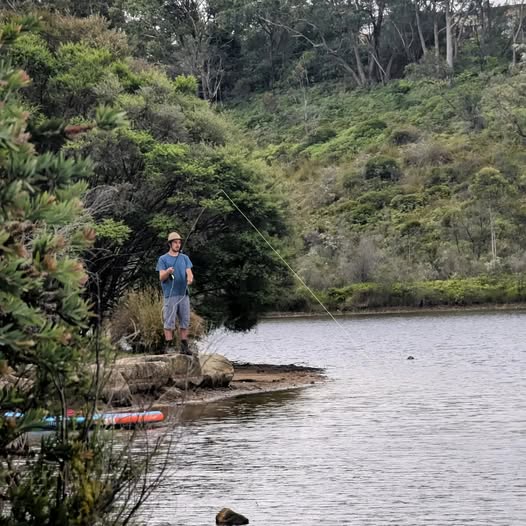
Blue Mountains Australia
One of the places we visited was the Blue Mountains. We went to a lake called Wentworth Falls. It is home to native and introduced waterfowl, native fish such as Gudgeons, and water bugs including freshwater crayfish, freshwater shrimp and dragonfly nymphs. Wentworth Falls Lake is a small water storage that was originally built to supply water for steam trains in 1878 well before the Blue Mountains Railway was electrified. The lake is now used only for recreation and is regularly stocked with trout.
While we were there, a young man showed up and was trying to cast a rod he received for Christmas. Surprisingly, there doesn’t seem to be many people who fly fish in Australia, so he was struggling finding help. I watched him struggle for a bit and then asked if I could help since I have taught thousands of people to cast and fly fish.
His two main issues were 1) he wasn’t pausing long enough and 2) he was using too much wrist. When teaching, it is important to break it down and explain why these things are faults and how they negatively affect the cast. So, let’s break it down.

Wentworth Falls Lake
So, what do we mean by pause? It is what is needed to allow the line to straighten out and bend the rod. A bent rod is a loaded rod so when someone suggests that you aren’t loading your rod, it simply means that you aren’t pausing long enough. On the back cast, the line should straighten out and bend the rod and it stays bent until you make the stop on your forward cast. If you fail pause long enough, you are losing energy in your cast. As we become better casters, we will start feeling the rod bend (load) but, in the beginning, sometimes it’s helpful to watch the rod bend on both the back and forward cast.
Wrist- this is a struggle for a lot of fly anglers. When we cast with our wrist, we tend to have too much arc. It is important that the rod tip move in a straight-line path- think about the rod tip moving across an imaginary ceiling and it never touching the walls. My friend Coach Mac on the Fly talks about watching your thumb. If you thumb is pointed at the sky, so is your rod tip. If your thumb is pointed back or down, so is your rod tip and you will have too much arc and the line will not go out straight. A rod moving straight creates a tight loop in the line and a rod moving in an arc is an open loop.
If you are struggling with your cast, I highly recommend getting a casting lesson with a qualified instructor. You can look to your local fly shop, or visit Fly Fishers International for a list of qualified instructors. I’m never a fan of “learning from a buddy” unless the buddy is an actual instructor. Too many times, we are taught someone’s bad habits, and it takes a lot more effort to break those habits than if you learn the proper way in the beginning. Like any other hobby, getting QUALIFIED help in the beginning, will save you from a lot of headaches later on.
I covered both of these faults in a fly casting instructional video with Arizona Game and Fish. Take a look and let me know what you think!
